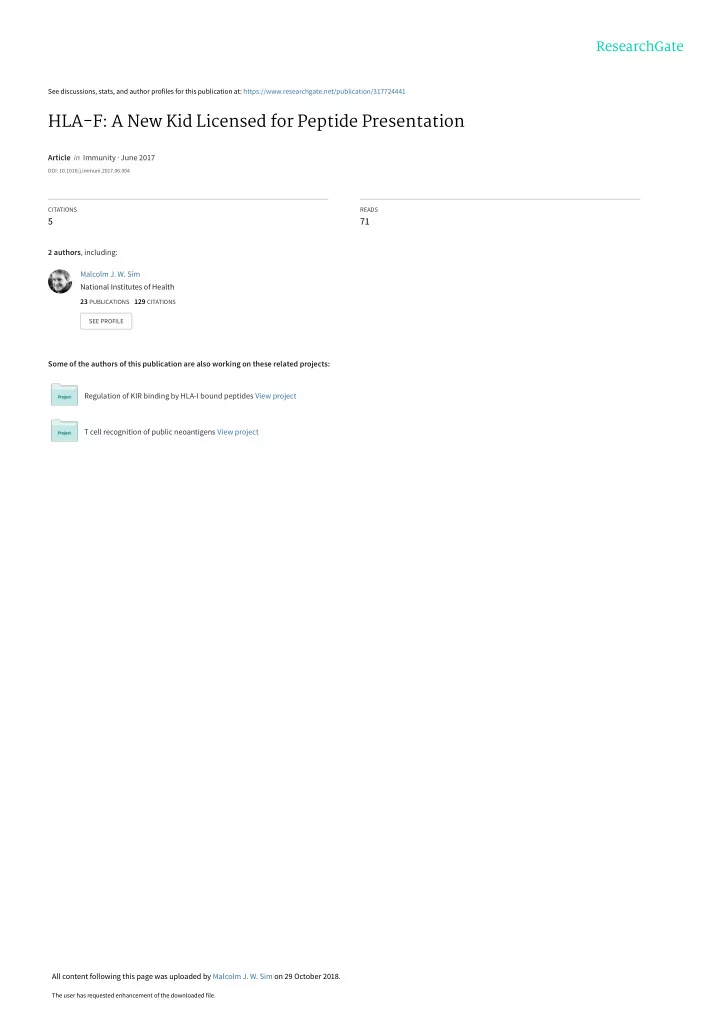

See discussions, stats, and author profiles for this publication at: https://www.researchgate.net/publication/317724441 HLA-F: A New Kid Licensed for Peptide Presentation Article in Immunity · June 2017 DOI: 10.1016/j.immuni.2017.06.004 CITATIONS READS 5 71 2 authors , including: Malcolm J. W. Sim National Institutes of Health 23 PUBLICATIONS 129 CITATIONS SEE PROFILE Some of the authors of this publication are also working on these related projects: Regulation of KIR binding by HLA-I bound peptides View project T cell recognition of public neoantigens View project All content following this page was uploaded by Malcolm J. W. Sim on 29 October 2018. The user has requested enhancement of the downloaded file.
Immunity Previews cellular miRNAs, rather than loss of siRNA Putnam, N., Barrows, N.J., Sherry, B., et al. Li, Y., Basavappa, M., Lu, J., Dong, S., Cronkite, (2014). J. Virol. 88 , 8065–8076. D.A., Prior, J.T., Reinecker, H.C., Hertzog, P., production. I would therefore argue that Han, Y., Li, W.X., et al. (2016). Nat. Microbiol. a definitive answer to the question of 2 , 16250. Bucher, E., Hemmes, H., de Haan, P., Goldbach, whether RNAi serves as a physiologically R., and Prins, M. (2004). J. Gen. Virol. 85 , 983–991. Maillard, P.V., Van der Veen, A.G., Deddouche- relevant antiviral innate immune response Grass, S., Rogers, N.C., Merits, A., and Reis, Cullen, B.R., Cherry, S., and tenOever, B.R. (2013). in mammals has not yet been obtained. E.S.C. (2016). EMBO J. 35 , 2505–2518. Cell Host Microbe 14 , 374–378. REFERENCES Parameswaran, P., Sklan, E., Wilkins, C., Burgon, Garcia-Sastre, A., Egorov, A., Matassov, D., T., Samuel, M.A., Lu, R., Ansel, K.M., Heissmeyer, Brandt, S., Levy, D.E., Durbin, J.E., Palese, P., V., Einav, S., Jackson, W., et al. (2010). PLoS and Muster, T. (1998). Virology 252 , 324–330. Benitez, A.A., Spanko, L.A., Bouhaddou, M., Pathog. 6 , e1000764. Sachs, D., and tenOever, B.R. (2015). Cell Rep. Kennedy, E.M., Whisnant, A.W., Kornepati, 13 , 1456–1466. A.V., Marshall, J.B., Bogerd, H.P., and Cullen, Qiu, Y., Xu, Y., Zhang, Y., Zhou, H., Deng, Y.-Q., Li, Bogerd, H.P., Skalsky, R.L., Kennedy, E.M., Fur- B.R. (2015). Proc. Natl. Acad. Sci. USA 112 , X.-F., Miao, M., Zang, Q., Zhong, B., Hu, Y., et al. use, Y., Whisnant, A.W., Flores, O., Schultz, K.L., E6945–E6954. (2017). Immunity 46 , this issue, 992–1004. HLA-F: A New Kid Licensed for Peptide Presentation Malcolm J.W. Sim 1 and Peter D. Sun 1, * 1 Laboratory of Immunogenetics, National Institute of Allergy and Infectious Diseases, NIH, 12441 Parklawn Drive, Rockville, MD 20852, USA *Correspondence: psun@nih.gov http://dx.doi.org/10.1016/j.immuni.2017.06.004 HLA-F, a non-classical MHC molecule, is not known to present peptides. Dulberger et al. (2017) show that HLA-F contains a distinct peptide-binding groove and can present a diverse array of peptides. LIR1, however, recognized HLA-F away from bound peptide, leaving open whether peptide-HLA-F-specific T and NK receptors exist. MHC class I (MHC-I) molecules play sents peptides derived from the leader exists as an open conformer (OC) devoid multiple important roles in both innate sequences of other MHC-I molecules of peptide and b 2 M, which functions as and adaptive immune responses. Im- and is recognized by the innate immune a ligand for NK cell receptors such as mune cells survey cellular health through receptor CD94:NKG2A, expressed pre- KIR3DS1 (Garcia-Beltran et al., 2016; interactions with MHC-I via presentation dominantly on natural killer (NK) cells. Goodridge et al., 2013). Although there is of peptide antigen derived from intra- HLA-G is a ligand for LIR1 (also known indication that HLA-F interacts with b 2 M cellular sources. MHC-I molecules— as ILT2 or LILRB1) and KIR2DL4 and in cell lines, structural evidence for this as- both classical (MHC-Ia) and non-classical thought to act primarily at the maternal- sociation is lacking (Lee and Geraghty, (MHC-Ib)—have common structural fea- fetal interface (Parham and Moffett, 2003). To circumvent this problem and tures that allow for this function, specif- 2013). However, HLA-F appears not to generate large quantities of HLA-F- b 2 M ically a peptide binding cleft composed fit this pattern and decades of work have complex sufficient for structural analysis, of the a 1 and a 2 domains, stabilized left unanswered the central question as the authors engineered b 2 M to HLA-F as through associations with b 2 microglobu- to whether HLA-F presents peptide anti- a single polypeptide chain for production lin ( b 2 M). Human MHC-Ia molecules— gen for immune surveillance. In this issue in insect cells (Dulberger et al., 2017). HLA-A, HLA-B, and HLA-C—are highly of Immunity , Dulberger et al. (2017) The X-ray crystal structure of this protein polymorphic, expressed on all nucleated demonstrate that HLA-F can present pep- revealed a canonical class I MHC fold, cells, and are the principle ligands for tide antigen by solving the first crystal with very little deviation from HLA-A2 or T cell receptors (TCR) and killer-cell structures of HLA-F. They characterize HLA-G. Similarly, the peptide-binding immunoglobulin-like receptors (KIR). Hu- the peptide repertoires derived from groove was open, akin to peptide-loaded man MHC-Ib molecules—HLA-E, HLA-F, HLA-F and present structural evidence molecules, not molecules with related and HLA-G—have limited polymorphism for HLA-F recognition by LIR1. MHC folds devoid of peptide like FcRn and non-uniform tissue distribution and Attempts to find HLA-F associated with or MICA. Evoking the classical study by are largely ligands for innate immune re- b 2 M and sequence peptides from HLA-F Bjorkman and Wiley (Bjorkman et al., ceptors (Parham and Moffett, 2013). have been largely unsuccessful (Good- 1987), there was a region of electron den- HLA-E and HLA-G have relatively well- ridge et al., 2010). Indeed, a growing sity within the peptide binding groove, defined roles in immunity. HLA-E pre- body of evidence suggest that HLA-F unaccounted for by HLA-F or b 2 M. This 972 Immunity 46 , June 20, 2017 Published by Elsevier Inc.
Recommend
More recommend